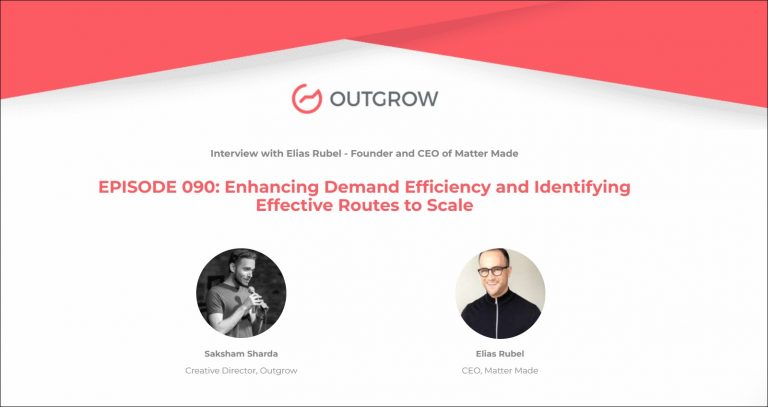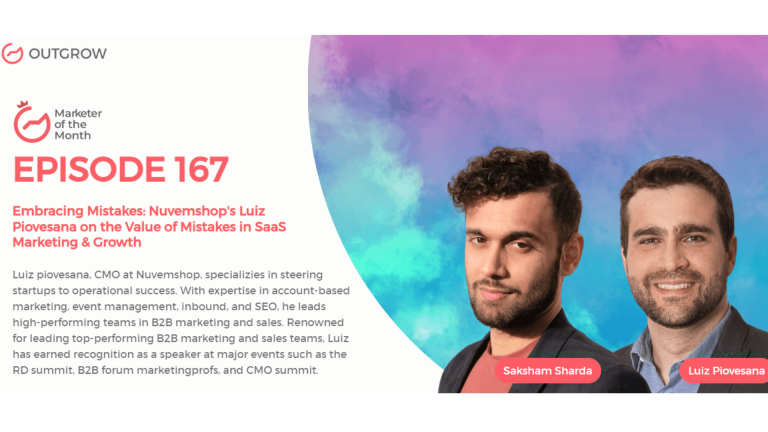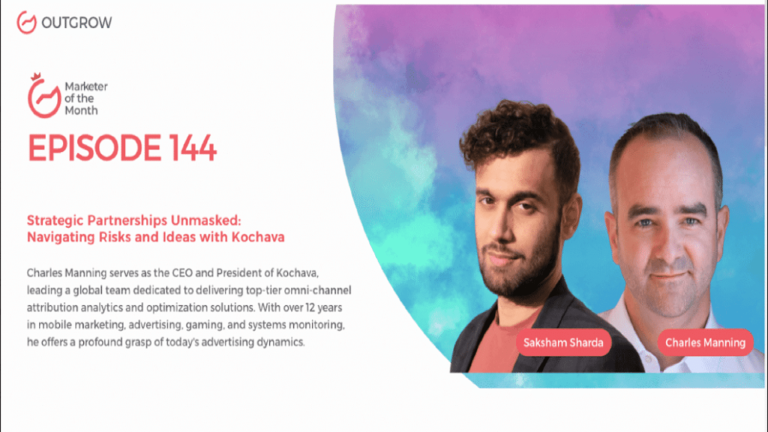EPISODE 110: Marketer of the Month Podcast with Sean Kim
Table of Contents
Hey there! Welcome to the Marketer Of The Month blog!
We recently interviewed Sean Kim for our monthly podcast – ‘Marketer of the Month’! We had some amazing insightful conversations with Sean and here’s what we discussed about –
1. Transforming Content Consumption: Lessons from Amazon and TikTok for a Revolutionary Experience
2. Unlocking Success with AI and Machine Learning: Building a Powerful Product Strategy
3. Empowering Content Entrepreneurs: Attracting Creators and Raising Awareness
4. Building a Strong Community: Education, Collaboration, and Customer Obsession
5. Revolutionizing Content Creation: Customer-Centric Product Development and Influencer Insights
6. Applying Customer Prioritization and Content Monetization: Lessons for Success
About our host:
Dr. Saksham Sharda is the Chief Information Officer at Outgrow.co. He specializes in data collection, analysis, filtering, and transfer by means of widgets and applets. Interactive, cultural, and trending widgets designed by him have been featured on TrendHunter, Alibaba, ProductHunt, New York Marketing Association, FactoryBerlin, Digimarcon Silicon Valley, and at The European Affiliate Summit.
About our guest:
Introducing Sean Kim, Ex-Head of Product at TikTok, and President and CPO at Kajabi, the leading platform for knowledge entrepreneurs. Tune in to this episode for Sean’s valuable insights on leveraging AI and machine learning to reshape the content landscape.
TikTok’s Architect Sean Kim Reveals the Explosive Power Behind the Short-Form Video Revolution
The Intro!
Saksham Sharda: Hi, everyone. Welcome to another episode of Outgrow’s Marketer of the Month. I’m your host, Dr. Saksham Sharda, and I’m the creative director at Outgrow.co. And for this month we are going to interview Sean Kim, who is the President and CPO at Kajabi. Thanks for joining us, Sean.
Sean Kim: Great to be here. Thank you.
Don’t have time to read? No problem, just watch the Podcast!
Or you can just listen to it on Spotify!
The Rapid Fire Round!
Saksham Sharda: The first one is to describe what your organization does in one sentence.
Sean Kim: Help creators monetize their knowledge.
Saksham Sharda: How long does it take you to get ready in the mornings?
Sean Kim: Five minutes
Saksham Sharda: What is the most valuable skill you’ve learned in life?
Sean Kim: To always listen to the customer.
Saksham Sharda: The city where the best kiss of your life happened.
Sean Kim: Seattle.
Saksham Sharda: How many speakers can you name at this conference?
Sean Kim: I can name 20. Oh, right now, actually name them?
Saksham Sharda: You said 20, so now name them.
Sean Kim: No, unfortunately, I don’t.
Saksham Sharda: That’s okay. In one sentence, describe one problem that your company is facing.
Sean Kim: One problem that the company facing is awareness.
Saksham Sharda: How do you relax?
Sean Kim: I watch Netflix.
Saksham Sharda: A habit of yours that you hate?
Sean Kim: I’ll pass
Saksham Sharda: Work from home or office?
Sean Kim: A mixture of both is important,
Saksham Sharda: The most embarrassing moment of your life?
Sean Kim: In first grade, I had my fly down and everyone in the class saw it.
Saksham Sharda: Okay, how many hours of sleep can you survive on?
Sean Kim: Four
Saksham Sharda: Your favorite app?
Sean Kim: My favorite app is the Kajabi app.
Saksham Sharda: Biggest mistake?
Sean Kim: It’s like multiple mistakes I’ve made. But you know, it’s all about failing and pivoting and learning and moving on.
Saksham Sharda: The first movie that comes to your mind when I say the word technology?
Sean Kim: What’s that movie, the Disney movie, where there are little kids?
Saksham Sharda: Wall-E?
Sean Kim: Wall-E, yeah.
Saksham Sharda: How many cups of coffee do you drink in a day?
Sean Kim: Two
Saksham Sharda: Favorite Netflix show?
Sean Kim: My favorite Netflix show would be “Suits”, as of right now.
Saksham Sharda: Good. All right. So that was the end of the rapid and you the rest of the questions you can answer with ease.
The Big Questions!
Saksham Sharda: Okay, so the first one is you’ve worked with some big names like Amazon and Tik Tok. So what were your experiences there? And how did you bring them into action here at Kajabi?
Sean Kim: Yeah, so I had amazing experiences at Amazon as well as TikTok, both those companies are really about focusing on the user or the customer, ensuring that you’re constantly thinking about how to improve the product, as well as services to ensure that you provide the best experience for them. So relentless focus on the customer, and relentless privatizations as well, was a very key skill set. And, you know what, what I did was I took all those learnings and apply them to Kajabi. And bring that knowledge here to this company. And what is critical is that you’re constantly thinking about the user, how we optimize for the user, as well as like, take on the biggest challenges that they have, right? So when you talk to those users and meet with them regularly, they’ll tell you to like, this is the biggest challenge that I have. And then you think about product solutions that could potentially help produce those challenges for them. And you know, it doesn’t have to be the immediate solution, you take it to take your time you build an MVP, you test it out, and you’ll learn along the way, some things will work, some things won’t, right. But you take those learnings and then eventually you have yourself an amazing product that you can offer your customers that can solve that big problem.
Saksham Sharda: So what would you have to say about the TikTok-ification of all news feeds that’s happening that we’re seeing across a lot of apps?
Sean Kim: So short-form video is the future, is the way people are gonna consume information. You know, that was one of the reasons why I joined TikTok three years ago, was actually when TikTok came to me and said, “Hey, let’s couple this company, it’s amazing.” I first downloaded the app at the time. And, you know, it was really interesting. I saw kids dancing and lip-syncing. And I thought like, Why the hell would I join this app? Leave Amazon for this no-name company three years ago? And I initially said, No. And so Alex Xu, the founder of Tiktok, actually called me and said, “Hey, come down to LA, let’s talk about it”. And when I flew down, he explained to me that, a short-form video is the future of constant consumption. And one of the things that they figured out was discovered how to help people discover new things. And it changed the way they consume content and knowledge. So if you’ve figured out discovery, it means that you can help people find places to eat or to travel, what books to read what movies or watch, and what’s the latest fashion trend. It was endless, right? So that’s when I had this lightbulb moment. And I realized, like, wow, this app could potentially change and revolutionize the world. And that was the reason why I joined Tik Tok and you can see now how the way short from the video has like changed, revolutionize other companies in terms of how they present their content.
Saksham Sharda: Where do you think the future of innovative technology is headed especially with AI and machine learning taking over?
Sean Kim: Yeah, it’s a fascinating space, it is going to help reduce a lot of the, you know, very manual tasks, right? It’s going to help us essentially get our jobs done faster. I think that, for instance, one example is that we’re at Kajabi. One of the big challenges from our customers is that it takes a lot of work to research and put together a course, for their audience, like they’re experts in this space. Still, they also need to research, need to gather all the information, they need to get the pictures, they needed to get the copyright, they need to organize it, and a lot of work goes into the creation of a course. But what AI can do is kind of help reduces some of that burden, right? So AI can help find the content help find the right images to use, and organize it in the right way that people want to consume the content. And essentially, like, take a lot of the burden away so that it you know, the Creator can focus on what they love, which is creating the content. So I think like, there’s a lot of use cases like this, that machine learning and AI is gonna help solve a lot of these problems in the future.
Saksham Sharda: And so what are some of the other ways that cause creation platforms to plan to use AI?
Sean Kim: Yeah, so of course, AI can also help our creators in terms of marketing as well. Right. So, you know, it can essentially take course content, it can take, it can learn about what their users or audience are interested in watching. Right. And it can essentially help the Creator create content around their courses to mark it out to their audience. So AI can be a big part of that whole journey. For instance, rather than the Creator watching the content and trying to figure out or understand what highlights to use to then mark it out to their audience and say, “Hey, here’s what the course is about. Here’s why it would help you solve your problems or whatever it might be and improve your quality of life.” AI can make that call and say, “Hey, here’s what you should highlight. Here’s how you should create a video, it should be vertical for Tiktok. It should be horizontal for you”. Here’s what music to add, right? So AI can kind of make those adjustments and calls for you so that it takes a lot of that burden out and all that manual work to try to recreate a short highlighted version of your course for marketing purposes. So I think that’s where a lot of exciting things can happen in the future.
Saksham Sharda: What in your opinion does a good product strategy look like?
Sean Kim: A good product strategy always starts with the customer problem. 100%, always. So it means talking to your customers regularly, doing survey analysis, but ultimately, understanding the most important challenge that they have and how you can use solutions to reduce some of the frak. So it always starts with the customer problem talking to customers and understanding their challenges, motivations, their pains, and thinking of potential solutions to remove those challenges. Some of the friction points are out there, you know, process, right? So, product strategy just again starts with the customer and ensures that you’re 100% focused on helping them. And then from there, it goes on to build up a potential MVP solution. And the MVP doesn’t have to be perfect, right? It’ll have some bugs, there’ll be it could potentially even be manual, it doesn’t even have to involve the engineering team, it can just be a marketing test, right? But you must be able to validate your idea, very quickly, make sure that it is solving a problem, and once you’ve validated it when you start adding additional resources, as well as, time to ensure that you can provide a better experience for your customer.
Saksham Sharda: So the tussle between data and entertainment, where would you locate an ideal product strategy?
Sean Kim: So I would say you don’t need 100% of the data to make a decision. Start with like, 60% of the data, right? I think if you have 100% of the data, I think you’re moving too slowly. So once you have 60% of the data, then you use that to make a judgment call, be decisive with that data, and then make the best MVP with that. And then you can get more data in to continually pivot or adjust your product to provide the best experience.
Saksham Sharda: How does Kajabi help content entrepreneurs earn over $3.5 billion using online tools?
Sean Kim: It’s 4.1 billion now. Yeah, so it’s an amazing, amazing product. You know, so we’ve helped 60,000 customers are in $4.1 billion to date. In Q3 of 2022, customers that built a business this year, have earned 20% More than the customers that started a business in 2021, and 2020. So overall, this company has been incredibly successful in terms of helping creators monetize their knowledge. And of the ways, we do this is we have an amazing product suite of features that help build a business from zero to one. So you don’t need to go anywhere else you need, you just need Kajabi to build that entire business, right? So we offer everything from building the website to the funnel, the landing pages, capturing email, sending out emails, and of course, the actual products such as courses, video courses, podcasts, and live stream newsletters, we also offer the ability to collect payment. So all those components are all part of this suite of products, and all those parts are essential parts of this Kajabi platform. So it’s an all-in-one platform that helps you monetize that knowledge. And it’s been very successful. We also have, hundreds and hundreds of educational content, in terms of how to build a business from zero to one, we have a huge, amazing community of creators who have already gone through this experience and want to share their playbook and how they were able to, you know, become successful in your specific field. So we have a very helpful robust community that is always there to just help new entrepreneurs out, right? And then we also have this amazing customer service team, that are experts in the space that will jump on a call with you to help you also build this business. So there’s just a lot of assets, a lot of education, as well as amazing tools to help creators monetize their knowledge.
Saksham Sharda: And how do you go about attracting more creators to your platform?
Sean Kim: Yeah, so that’s why I’m here at the Web Summit to make sure that people are aware that this amazing platform exists called Kajabi. We are arguably one of the most successful crater economy startups out there today. We have again, 60,000 customers who have made $4.1 billion. And so, you know, I think it’s really important that people understand that this platform is there for people to leverage and become successful in what they do.
Saksham Sharda: So what’s one lesson you learned working as a product manager at Amazon and one from TikTok that you’d like to give to our audience, content creators, marketers, founders, and entrepreneurs?
Sean Kim: So at Amazon, definitely focusing on the customer and ensuring that your customer-obsessed 100% all the time, I still meet with customers every single week, every single week, I spent at least two or three hours meeting with customers to understand their motivations, their pains, what’s working, what’s not working, I meet with customers that are brand new customers that have been around for a while, customers that make zero money, customers that make a million, 100 million, very different problems, right. So I think meeting with customers and understanding their pain points, and being customer success is critical. It grounds you and ensures that you’re building things and servicing them. So that’s what I learned at Amazon. At TikTok I think like, one of the most amazing things I’ve learned is how important it is to help creators. So one of the most important things I learned at TikTok was how creative people can be, and providing tools to inspire that creativity was interesting. One of the features that we learned, one of the features that we launched at Tiktok when I was era was called Stitch. Stitch is a feature that lets you watch one creator’s video and then stitch your ending to it. And we saw this experience happening outside the app, people were downloading videos, stitching their videos, and then re-uploading it was decided, well, we should make it much easier to do it inside the app. And sure enough, as soon as we launched it, it just took off. And we saw lots of really interesting use cases coming out of it. Now creators are asking their audience questions, and the audience will respond with a video. So for instance, you know, really fun popular use cases, like questions like tell me your Harry Potter fan without telling me our Harry Potter fan, for instance. Right? So there are a lot of use cases like that that came out and it just became a natural part of creating content. And so I think finding these ways to help creators collaborate was really good learning for us.
Saksham Sharda: One sentence about what you’d like to say about Elon Musk’s acquisition of Twitter.
Sean Kim: *Guessing*
Sean Kim: The right thing to say is it’s gonna be a very interesting journey. And I wish you luck.
Saksham Sharda: And the last question for you is of a personal kind, what would you be doing in your life if not this right now?
Sean Kim: When I was kid, I’ve always wanted to be an astronaut. And you know, I think like, just space fascinates me. And I read about it. I watch movies about it all the time. Sci-Fi is my favorite genre of content. I study black holes and so it’s one of those things that I’ve always had. I always had a passion for
Saksham Sharda: That was great.
Sean Kim: Awesome. Thank you so much.
Let’s Conclude!
Saksham Sharda: Thanks, everyone for joining us for this month’s episode of Outgrow’s Marketer of the Month. That was Sean Kim, the President and CPO at Kajabi. Thanks for joining us, Sean.
Sean Kim: Pleasure. Thanks for having me.
Saksham Sharda: Check out the website for more details and we’ll see you once again next month with another marketer of the month.








